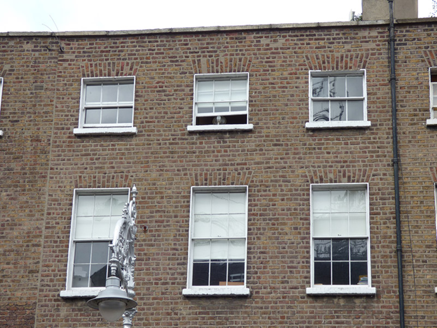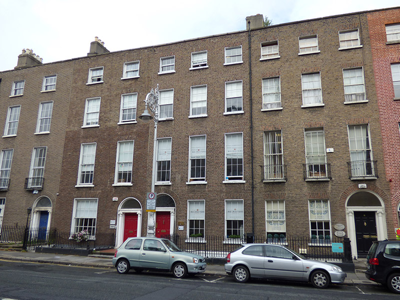Survey Data
Reg No
50100496
Rating
Regional
Categories of Special Interest
Architectural, Artistic
Original Use
House
In Use As
Office
Date
1770 - 1790
Coordinates
316693, 233299
Date Recorded
28/07/2016
Date Updated
--/--/--
Description
Attached three-bay four-storey former house over basement, built c. 1780 as pair with No. 6, and having single and two-storey return to rear of south bay. Now in use as offices. M-profile pitched slate roof, hipped to south end, with further shared roof to part of valley, behind parapet with granite coping. Rendered chimneystacks to north party wall with terracotta pots; concealed rainwater goods. Flat roofs to return. Flemish bond brown brick walling on painted masonry plinth over painted rendered basement walling. Square-headed window openings, diminishing in height to upper floors, with patent reveals and painted masonry sills. Timber sliding sash windows without horns (except for one top floor window), three-over-three pane to top floor and six-over-six pane elsewhere. Steel grilles to basement at front. Round-headed door opening with painted masonry doorcase, having moulded rendered surround, moulded cornice and fluted frieze with rosettes over Adamesque Ionic columns, replacement leaded fanlight and nine-panel raised-and-fielded timber door with replacement brass furniture. Inclined granite platform with iron boot-scrape. Plainly detailed door opening beneath entrance platform with recent door and window. Basement area enclosed by wrought-iron railings with decorative cast-iron posts on painted moulded granite plinth. Yard to rear, and later buildings to rear of plot. Cast-iron coal-hole cover to pavement.
Appraisal
No. 7 Fitzwilliam Street Lower is a late eighteenth-century house, built as a pair with No. 6, as part of the original laying out of the street, which was begun about 1780 in tandem with Merrion Square East and South. The building is characterized by typically well-balanced Georgian proportions. The façade is enhanced by its Ionic doorcase and by other features, including decorative balconettes and the relatively intact setting features that enrich the historic streetscape. The building house is part of a cohesive Georgian row lining the west side of the street.















